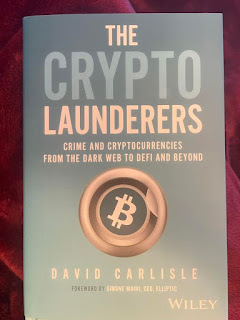Source: securityboulevard.com – Author: Gary Warner
The Crypto Launderers: Crime and Cryptocurrencies from the Dark Web to DeFi and Beyond – by David Carlisle
I wish I had a way to review this book without having first read last year’s “Tracers in the Dark.” While Tracers talked about the people involved in investigating various crypto-based crimes and those early researchers who made the tracing process possible, Carlisle tells many of the same stories, but in a less engaging way. The facts are there, and when they talk about the same cases, they align nicely. But Andy Greenberg’s Tracers makes those cases stories about people, while Carlisle portrays facts without character development which I would not have realized was necessary or useful in a book on Money Laundering had I not read Tracers first.
As to the facts? I learned a ton, especially by feeding my ADD nature by chasing interesting footnotes — more than 350 references are provided! Thank you!!!
In the early part of the book he covers all of the mandatory cases: Silk Road, Mt. Gox, etc.
Where this book is great, and it is far superior to Tracers as an educational resource in this regard, is how money-laundering works in Crypto. Mixers and Coinswaps are explained well, with several of the related cases such as Helix and Bitcoin Fog, being explained. The importance of regulation and how regulators have followed behind crypto developments is a major theme of the book. From regulating exchanges, to Bitcoin ATMs, to privacy wallets such as Wasabi Wallet, and the debate on whether privacy wallets can or should be regulated.
The attempts of FinCEN to introduce further regulations and the (in my opinion) Astroturfed outcry against them is especially interesting.
An example of what I believed to be a very rational and necessary AML policy would be the FinCEN Draft Rule-Making Proposal, introduced 18dev2020 for “requirements for certain transactions involving convertible virtual currencies or digital assets” tried to require transactions greater than $3k to require proof of the identity of the recipient if sent to a private wallet, and would have required a currency transaction report on any movement above $10k. The outlash was severe and the rule-making placed on hold.
A nice coverage of the history of crypto sanctions by OFAC is also portrayed, from Suex, Chatex, Garantex, Bitzlato, and IRGC-related ransomware. And a history of the evolution of ransomware, which would not be possible without those unidentified and unaccounted for large currency transactions that cryptocurrency has enabled (and that FinCEN has been TRYING to prevent!)
One example of sanctioning crypto was the OFAC sanctions against Lazarus Group Ethereum addresses, sanctioned along with one of their chosen Mixers, Blender.io. (Sanctioned addresses are listed here.) I appreciated some of the additional details Carlisle provided on Lazarus Group crypto hacker money launderers Tian Yinyin and Li Jaidong (snowjohn and khaleesi) who moved at least $100M, including purchasing at least $1.4 M in Apple iTunes gift cards! (Though again, no “characters”, just names.)
The latter part of the book does a nice job explaining the way Ethereum opened up a number of possibilities with Smart Contracts. Carlisle does a great job explaining Ethereum and ERC-20 tokens and how DAOs, DEXs, and DApps are built using the Smart Contracts of Ethereum with more on the DeFi system including how Bridges work. He also explains NFTs and how they also were supercharged by ERC-721 (and abused by thieves, fraudsters, insiders, and money launderers.) This was the best introduction to that whole ecosystem that I’ve read. Great job!
The Bitfinex hack, which opens the book, focused on 94,643.29 BTC from 2016 sitting under a microscope, untouched for six years, until it moved in Feb 2022 leading to the arrest of Dutch and Razzlekhan with $3.5 Billion seized, felt like it was set up as the climax of the book as we returned to the story from the opening chapter. The intermediary chapters helped us understand the now-revealed mechanisms, but again, it was facts without characters, which is fine – I just got ruined by the engagement of Tracers.
The final chapter seems like something the Elliptic marketing department forced on him. (The other major crypto industry players all do the same thing, so not picking on Elliptic. It was the first crypto tracing tool I ever used!) The obligatory industry toeing the line of “oh, but less than 1% of crypto transactions are illicit!” was a frustrating end to an otherwise decent book. No one will ever convince me that the vast majority of crypto transactions involve no “transaction” at all, but are wash trading at an inconceivable scale designed to manipulate the value of cryptocurrencies to encourage investment and enrich the HODLers and corporations whose livelihood crypto is.
Fantastic content – even possibly as an accompanying text for a crypto crime course at a university (yes, my wheels are turning!) especially with the rich depth of referenced articles, policies, and cases. But for a fun crypto crime STORY I would still go with “Tracers In the Dark.”
*** This is a Security Bloggers Network syndicated blog from CyberCrime & Doing Time authored by Gary Warner. Read the original post at: https://garwarner.blogspot.com/2024/01/book-review-crypto-launderers-crime-and.html
Original Post URL: https://securityboulevard.com/2024/01/book-review-the-crypto-launderers-crime-and-cryptocurrencies/
Category & Tags: Digital Currency,Security Bloggers Network,Bitcoin,book review,crypto currency,Ethereum,Mixers,sanctions – Digital Currency,Security Bloggers Network,Bitcoin,book review,crypto currency,Ethereum,Mixers,sanctions
Views: 0





















































